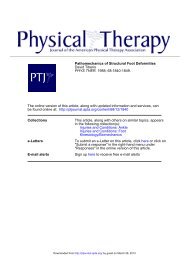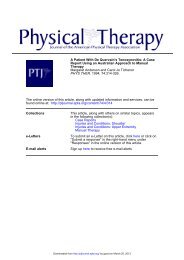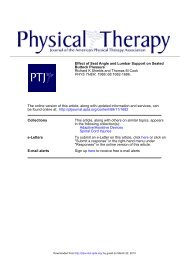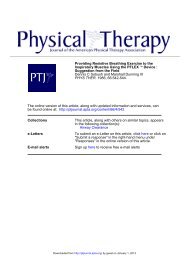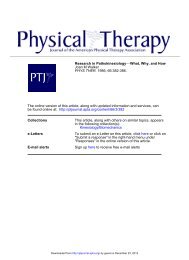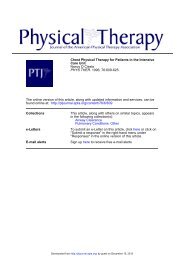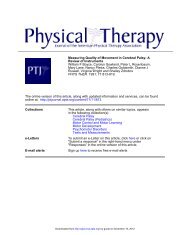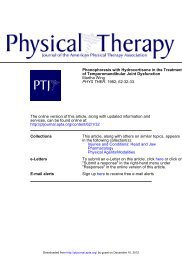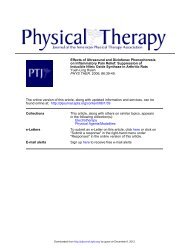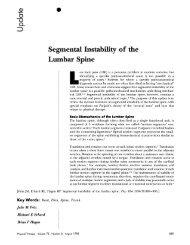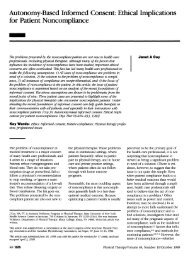Hemiplegic Shoulder Pain - Physical Therapy
Hemiplegic Shoulder Pain - Physical Therapy
Hemiplegic Shoulder Pain - Physical Therapy
Create successful ePaper yourself
Turn your PDF publications into a flip-book with our unique Google optimized e-Paper software.
passive elevation of the arm. Spasticity<br />
may increase the likelihood of impingement<br />
during GHJ abduction, because<br />
spastic rhomboid muscles fix the scapula<br />
in downward rotation, and spastic<br />
adductor-medial rotator muscles prevent<br />
lateral humeral rotation. 8,23 Spasticity,<br />
thus, might contribute to impingement<br />
during active and passive GHJ<br />
abduction. Several authorities in stroke<br />
rehabilitation have discussed the importance<br />
of reducing tone and adhering to<br />
biomechanical principles during passive<br />
elevation of the spastic shoulder. 30-32<br />
Improper passive exercise by health<br />
care professionals, family, or patients<br />
themselves may be a major cause of<br />
shoulder pain in hemiplegic patients.<br />
3,8,11,33 Failure to provide upward<br />
scapular rotation and lateral humeral<br />
rotation during passive abduction are<br />
the most frequently mentioned mechanisms<br />
of pain. Use of overhead pulleys,<br />
furthermore, has been cited as a cause<br />
of impingement pain 17,34 and even rotator<br />
cuff rupture. 17 No controlled studies,<br />
however, have been conducted in this<br />
area.<br />
Rotator cuff rupture. Partial tears of<br />
the rotator cuff are common after 50 or<br />
60 years of age. 27-28 Wear that is secondary<br />
to impingement has been cited as a<br />
major contributing factor in rotator cuff<br />
tears. 35 A fall or stress causing forcible<br />
abduction without lateral rotation can<br />
convert a partial tear to a complete rupture.<br />
36 Degenerative changes, however,<br />
can be so severe that even minor injuries<br />
in nonhemiplegic patients can precipitate<br />
a complete tear. 27 Patients with rotator<br />
cuff rupture have symptoms of<br />
severe pain, especially with passive flexion<br />
or abduction; tenderness with palpation<br />
at the rupture site; and atrophy<br />
and weakness of the lateral rotator and<br />
the deltoid muscles. 27,37<br />
Several arthrographic studies in hemiplegic<br />
patients have revealed a high incidence<br />
of rotator cuff tears. Ruptures<br />
were found in 33% of hemiplegic patients<br />
with painful, stiff shoulders; none<br />
of the patients had a premorbid history<br />
of pathological conditions of the shoulder.<br />
38 Examining only patients with severe<br />
paralysis, Najenson et al found a<br />
40% incidence of rotator cuff rupture<br />
on the affected side compared with a<br />
16% incidence on the nonaffected<br />
side. 17 Najenson et al further associated<br />
pain with rotator cuff rupture and subluxation;<br />
all of the 11 patients with severe<br />
pain had subluxation, and 10 had<br />
rupture of the rotator cuff. 17<br />
The cause of rotator cuff rupture in<br />
hemiplegia has been identified as impingement<br />
during passive abduction<br />
above 90 degrees 3 and as forced abduction<br />
without lateral rotation, especially<br />
with the use of overhead pulleys. 17 Rotator<br />
cuff rupture also may be facilitated<br />
by prior degenerative changes and by<br />
subluxation, 17 trauma during falls, 38 and<br />
repeated small traction injuries. 39<br />
Adhesive capsulitis. Conversely,<br />
other investigators have noted that adhesive<br />
capsular changes, not rotator cuff<br />
ruptures, are the predominant findings<br />
during arthrography of hemiplegic<br />
shoulders. Rizk et al performed arthrographic<br />
studies of 30 patients with stiff,<br />
painful shoulders and reported a 77%<br />
incidence of adhesive capsulitis; they<br />
saw no evidence of rotator cuff rupture.<br />
12 Hakuno et al, performing arthrography<br />
on both affected and unaffected<br />
shoulders in 77 randomly selected<br />
hemiplegic patients, found an equal incidence<br />
of rotator cuff rupture on affected<br />
and unaffected sides (22% and<br />
24%, respectively). 40 Hakuno et al further<br />
reported that adhesive changes were<br />
noted the most frequently during arthrography.<br />
Although adhesive changes<br />
were noted in both paralyzed and nonparalyzed<br />
shoulders, 55% of the paralyzed<br />
shoulders with adhesions had multiple<br />
adhesion sites compared with 4%<br />
of nonparalyzed shoulders. Adhesions<br />
in the GHJ and the subscapularis bursae<br />
were associated significantly with limited<br />
GHJ motion; adhesions in the bicipital<br />
tendon sleeve were associated significantly<br />
with subluxation but not with<br />
ROM restriction. 40<br />
The classical clinical picture for adhesive<br />
capsulitis 41 is strikingly similar to<br />
that described previously for HSP. The<br />
cause of adhesive capsulitis even in nonhemiplegic<br />
patients is unknown. 27 The<br />
most significantly related factors in development<br />
seem to be prolonged immobilization<br />
secondary to pain and age<br />
greater than 40 years. 27,28,41,42 <strong>Pain</strong> secondary<br />
to impingement may be a precipitating<br />
factor. 41 DePalma has noted<br />
that the ages of the greatest incidence of<br />
adhesive capsulitis and the most degenerative<br />
soft tissue changes are the same<br />
(40 to 60 years). 27 Suprascapular neuropathy<br />
also has been associated with<br />
frozen shoulder. 43<br />
In hemiplegic patients, the development<br />
of adhesive capsulitis has been<br />
related to paralysis, 10,40 unconsciousness,<br />
10 impingement pain, 3 and subluxation.<br />
20 The precise cause, however, remains<br />
obscure.<br />
Glenohumeral joint malalignment. Inferior<br />
subluxation of the GHJ appears<br />
more frequently in patients with hemiplegia<br />
than in other geriatric patients.<br />
Reviewing radiographs of 300 geriatric<br />
patients, Carpenter and Millard reported<br />
a 5% incidence of subluxation;<br />
80% of the subluxations were superior<br />
in the nonhemiplegic patients. 44 All 5 of<br />
the hemiplegic patients had inferior subluxation,<br />
and 4 of these had bilateral<br />
subluxation. The magnitude of inferior<br />
subluxation on the affected side, however,<br />
was much greater than on the unaffected<br />
side. Radiographic studies by<br />
other investigators have not demonstrated<br />
subluxation on the unaffected<br />
side. 245<br />
In hemiplegic patients, without regard<br />
to severity of paralysis or time since the<br />
onset of the hemiplegia, the incidence<br />
of inferior subluxation has been reported<br />
variously as 30%, 2,40 56%, 14 and<br />
64%. 20 In patients with severe paralysis,<br />
the reported incidences of subluxation<br />
usually are substantially higher: 66%, 2<br />
81%, 17 and 92%. 46<br />
Subluxation appears to develop during<br />
the several weeks immediately after<br />
the stroke, when flaccid paralysis prevents<br />
normal muscle response to loading.<br />
47 Using radiological examinations<br />
of stroke patients within 24 hours of<br />
their admission to the hospital, Smith et<br />
al found 60% of their patients with complete<br />
paralysis had GHJ malalignment.<br />
48<br />
Some evidence exists that subluxation<br />
may be irreversible after a certain period<br />
of time, regardless of return of active<br />
motion or spasticity in the deltoid and<br />
supraspinatus muscles. Longitudinal<br />
electromyographic studies demonstrated<br />
that subluxation developed during<br />
the flaccid period and did not occur<br />
after the supraspinatus muscle demonstrated<br />
EMG activity in response to<br />
loading. Having developed, however,<br />
the subluxation did not reverse even<br />
when supraspinatus muscle EMG activity<br />
became evident. 17 Some anecdotal<br />
reports indicate that, in many patients<br />
who have chronic subluxation at rest,<br />
temporary reduction of the subluxation<br />
can occur during ambulation 9 or during<br />
voluntary effort. 14<br />
Removal of the usual glenohumeral<br />
stabilizing mechanisms described by<br />
Basmajian and Bazant 49 permits inferior<br />
displacement of the humeral head in<br />
relation to the glenoid fossa: Specifically,<br />
superior tilting of the glenoid fossa<br />
is reversed secondarily to paralysis of<br />
the muscles that rotate the scapula up-<br />
1886 PHYSICAL THERAPY<br />
Downloaded from<br />
http://ptjournal.apta.org/ by guest on December 15, 2012




